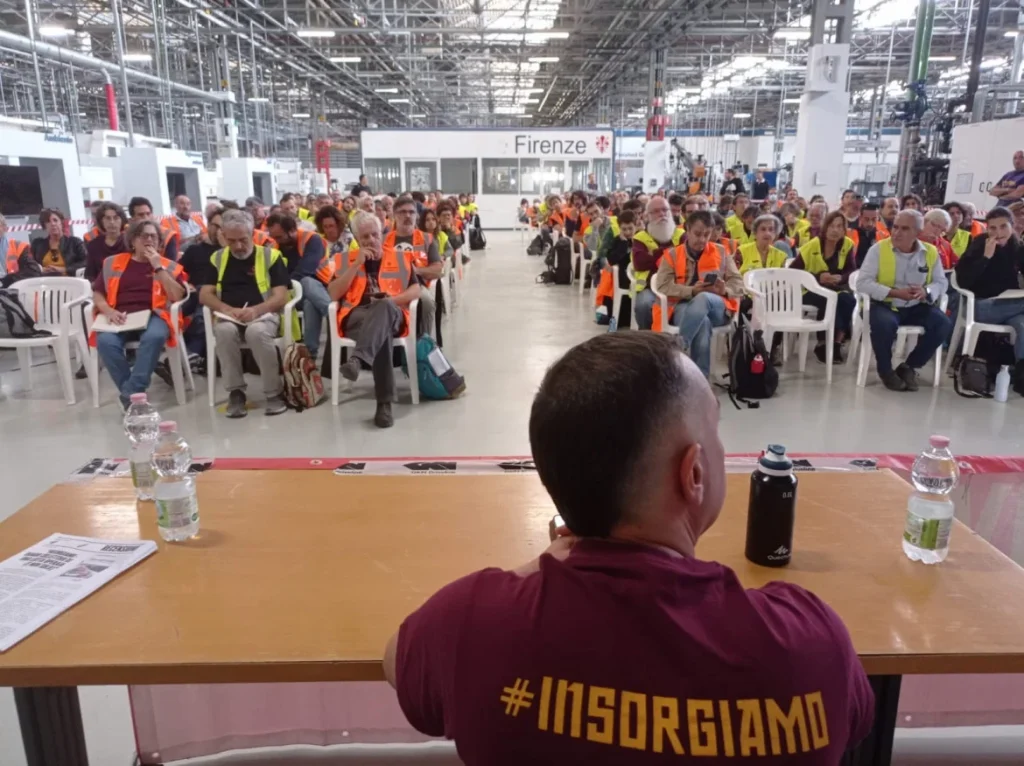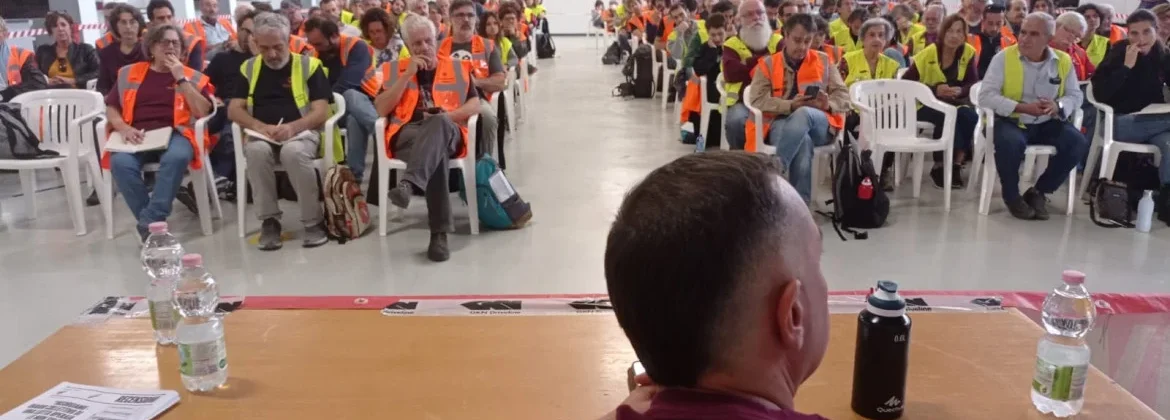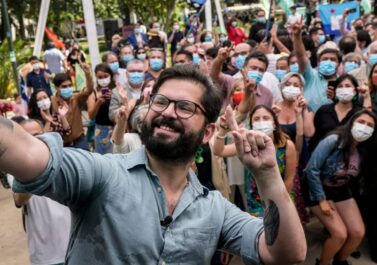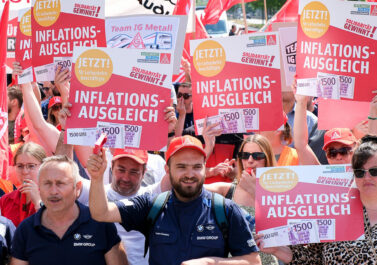
For two years, the workers of the former car supplier GKN Driveline near Florence have been occupying their factory. They are fighting to keep their jobs – and striving for an eco-socialist revolution. A visit to a unique experiment.
By Anna Jikhareva, Ayse Turcan (text) and Michele Lapini (photos), Campi Bisenzio
Below is a translation of a recent news article about the ongoing factory occupation and reindustrialisation plan at the GKN factory in Italy. It’s a good recap of what’s happened so far. For us, this struggle is probably the most politically important development of the real workers’ movement of recent times, which is why we’ve written about it in previous articles, which can be found here and here. It points us in a positive direction towards a new society, because it’s not just about ‘worker’s control under capitalism’, but a living example of an attempt to build a class movement and program based on our collective social and productive knowledge.
Massimo Cortini walks through the corridor leading to the factory hall. The chain lock at the end is to ensure that no one enters the production facility with the expensive machines, the 48-year-old explains before climbing over the barrier. “Everything here looks the same as the day they closed us down.” As Cortini steps into the hall, hundreds of machines, racks and pipes come into view. Forty million euros – that’s how much the equipment gathered here, the ultra-modern robots, some still in their original packaging, and shrink-wrapped goods are worth, Cortini says.
The huge factory hall is the heart of the automotive supplier GKN Driveline. Once part of the Fiat empire, the factory was owned by the British group GKN in the nineties before it was taken over by the investment fund Melrose Industries in 2018. They used to produce driveshafts for Fiat, Renault, Toyota and BMW, even Ferrari and Maserati, Cortini lists with a touch of pride in his voice. “We were the world market leader.”
Production on the 26,000-square-metre site has been at a standstill for two years. Instead, in the industrial area of Campi Bisenzio, half an hour’s bus ride from Florence, a unique experiment has emerged: the attempt at reindustrialisation from below, GKN for Future. The workers want to practically combine climate and class struggle – their goal is the democratisation of production and the ‘ecologisation’ of products. Or, in a nutshell: shift from car parts to cargo bicycles. The movement around Cortini and his comrades-in-arms has become perhaps the greatest eco-socialist hope in Europe.
On that hot Sunday in mid-June, when Cortini was leading a tour of the factory, representatives of the Italian climate movement, trade unionists, students in solidarity and workers from other factories, from Umbria, Naples or Trieste, had gathered in the stuffy factory canteen to learn from the public laboratory of self-management that the place had become. Many of the eighty or so participants wear the GKN shirts that can be bought one floor below. The logo is based on the original product, the drive shaft.
The story of the GKN workers’ suffering and struggle begins on 9 July 2021 with an email. On that memorable Friday, all 422 employees and around 80 temporary workers suddenly receive their notice of termination without warning: they would no longer have to come to work on Monday. The mass dismissal comes – contrary to promises – only a few days after an agreement between the government, trade unions and employers’ association expired that had banned dismissals during the Covid crisis. The Florence site is thus history, production is being relocated abroad – for the purpose of maximising profits and in keeping with the motto of Melrose Industries: “Buy, improve, sell.”
Instead of looking for a new job, the workers simply occupied the factory. Since then, a red banner with the movement’s logo has been hanging above the entrance, with messages of solidarity emblazoned on the fence. Because an occupation would be quickly evicted, they use a trick – and speak of a “permanent assembly”, which is legal.
Massimo Cortini, whom everyone just calls “Berva”, which means beast and does not at all fit his friendly manner and lanky appearance, grew up nearby. In 1998 he started his first job at the factory, which he says he enjoyed. During the tour, he points here to a robot, there to a milling machine, takes a part of a crankshaft in his hand to explain how it works. At some point he stops in front of a machine tool: “This is mine. He used to work here in shifts: from 6 am to 2 pm, 2 pm to 10 pm or 10 pm to 6 am.
The closure in the summer two years ago was a shock for Cortini. “Even after a week, I still couldn’t get over it mentally,” he says. Every day, he says, he came to the factory – with the feeling that he was going to work. Instead, he went to the meetings of the Collettivo di Fabbrica GKN, something like the control centre of the resistance. The collective had motivated him to fight from the beginning.
The legacy of operaism
If you want to understand how the struggle for the GKN factory in Campi Bisenzio could become a model, you have to go back a few years in history. After Sunday’s conference in the refectory is over, Matteo Moretti finds time to tell about the origins of the Collettivo.
Moretti (46), stubbly short haircut, in the obligatory GKN shirt, has maintained the machines in the factory for over twenty years. According to him, the fact that the struggle for future production could become a model is thanks to the maximum unionisation in the factory. In 2007 Moretti joined the metalworkers’ union Fiom, which is part of the Italian trade union confederation CGIL – in order to revolt from within the union only shortly after he joined. “We felt the union did not represent our interests, so we reorganised,” he says.
Under the umbrella of a grassroots factory council, which included not only elected representatives like Moretti, but also external supporters and many of the previously inactive workers, a kind of autonomous counterweight to the traditional unions, which over the years had increasingly taken to managing the stalemate, was formed. “Creating a class consciousness,” Moretti calls it. In 2018, this gave rise to the Collettivo di Fabbrica.
The collective has its headquarters in the trade union container in the middle of the factory hall. On the walls of the otherwise unadorned office hangs a black and red flag with the inscription “26 Julio”, the starting date of Fidel Castro’s Cuban revolution. Other flags stand for struggles and groups with which one shows solidarity with or which are remembered here: the Kurdish liberation struggle in Rojava, or the hot autumn at the Fiat Mirafiori factory in Turin in 1969, when the workers there prepared the ground for a more militant trade union policy.
Moretti and his comrades-in-arms also refer to this heritage. “We took our cue from the history of our country,” he says. He is referring to the experiences of the class struggle known as Operaismo in the 1960s and 1970s – a neo-Marxist movement that organised strikes in northern Italy to fight against the alienation of factory work; the Collettivo di Fabbrica is modelled on the councils that were established in many factories at the time. Unfortunately, this instrument has been destroyed, says the trade unionist. “With the agreements between companies and unions in the nineties, workers’ autonomy was taken away.”
The attitude that the class struggle should not only be waged in the factory itself also has its origins in that time. The members of the collective are strongly anchored in the region, not only at the demonstrations or in the Centri Sociali, the autonomous centres in the area, but also in the local football club, in the church, or in the voluntary fire brigade and other institutions of civil defence. Solidarity with other political initiatives is also crucial. There is hardly a demonstration or strike in the region and beyond without the presence of the movement that has grown up around the factory. Their motto: “Insorgiamo con i lavoratori GKN”, we rise up with the GKN workers – based on a motto of the Florentine Partigiani, the partisans during World War II.
The day before the conference, for example, Cortini, Moretti and the others travel to Bologna with their red “Insorgiamo” banner. Together with 10,000 other protesters, they denounce the government’s inaction after the devastating flood in Emilia-Romagna and cheer when a truck full of mud is dumped in front of the regional administration. On the day of the conference itself, a visit is made to a furniture dealer in the neighbourhood, where workers are on strike for fair wages. And one day later, collective members gather in front of the Greek consulate in Florence to make a statement against the deaths in the Mediterranean.
The often somewhat shallow slogan of “uniting struggles” used in the left-wing discourse is put into practice in Campi Bisenzio. If you show solidarity with others, you get solidarity back, that’s the simple formula. In March 2022, for example, tens of thousands demonstrated in Florence for the concerns of the factory workers.
In the two years since the factory closure, the GKN struggle has gone through various phases. First, the workers took legal action against the dismissal. In December 2021, however, the entrepreneur Francesco Borgomeo bought the site. Financial media reported at the time that Borgomeo, who had actually been appointed to liquidate the factory, had paid only one euro for it.
Borgomeo committed himself to finding investors for a new industrial project within six months. If this did not succeed, he promised, he would invest his own capital in a conversion of the production. Months of short-time pay and uncertainty followed, numerous roundtables and meetings with the Ministry of Economy, the trade unions and the new CEO. Borgomeo let deadline after deadline pass, he never presented a plan for the future or an investor. Then, last November, the workers suddenly stopped receiving their wages.
In the meantime, it has been almost nine months without income, which has left its mark on all of the workers. Many say that the struggle is currently at a difficult point, describing the time of waiting as gruelling, which is probably also Borgomeo’s goal: as the factory owner, he has the longer leverage and can simply sit out the conflict. While at the beginning the majority of the workers joined the occupation, today there are about 180 workers left. Those who remain are pursuing different strategies to deal with the loss of income: Some take out loans, others apply to the solidarity fund that supporters have set up, or get help from their families. “I am lucky, I have already paid off the mortgage on my house,” says Massimo Cortini. In addition, his wife works full time. “That has helped me to be more relaxed about everything.”
“At the moment we are fighting on several fronts,” says trade unionist Matteo Moretti. For one thing, he says, it’s about wages. The National Institute for Social Welfare (INPS) would pay compensation for loss of wages, but for that they need information from Borgomeo, which he does not provide. For Moretti, this amounts to nothing else but “blackmail”. The day after the meeting at the factory, a delegation protested at the INPS office in Florence. On the other hand, there is the second struggle, says Moretti, the one for reindustrialisation from below. “We want to be able to work in the factory again.”
Reindustrialisation 2.0
Long before it became clear that Borgomeo’s promises could not be relied upon, the workers took the future of the factory into their own hands. Shortly after the closure, a group gets together to draw up a plan for the ecological conversion of production: ecologically compatible goods instead of parts for the polluting car industry. Francesca Gabbriellini is also part of the group. The 34-year-old met the people around Moretti and Cortini in 2016 at a political event. When she heard about the mass dismissal at GKN Firenze five years later, she rushed to Campi Bisenzio with her university colleagues from Pisa. “We slept in the factory and helped out where we were needed,” the historian says in a Zoom call from Paris, where she is currently a PhD student.
When the occupation was only a few weeks old, the collective asked Gabbriellini and other solidary scientists from various disciplines to use their knowledge for GKN. “But everything was based on the vision of the workers,” she stresses. The first comprehensive industrial plan developed by the group envisages a shift in production from drive shafts for passenger cars to drive shafts for buses. The Italian state is also supposed to support this transition, but although this shift from individual to public transport would be ecologically very desirable, the authorities show no interest in the idea – forcing the collective to rethink.
In the meantime, a new plan has been drawn up, Reindustrialisation 2.0: in future, the factory will be run as a cooperative and produce cargo bikes and solar panels instead of drive shafts. Crowdfunding recently raised 170,000 euros, and the collective is now looking for investors. The elegant prototypes of the bikes can already be seen at the factory entrance – they also bear the GKN logo.
Emanuele Genovese has travelled from Rome for the conference in the factory canteen. The 25-year-old environmental economics student is part of Fridays for Future (FFF) Italy – and partly responsible for the fact that the climate movement and GKN workers are closely linked. “A friend called me in October 2021 and said there was a big thing happening in Florence,” Genovese recalls. The climate activists then got in touch with the collective. “We were very impressed by them – they not only had very clear visions of ecological transformation, but also a new idea of work.”
Even though not all workers were enthusiastic about the conversion idea from the start, the debates always ended with consensual decisions. This democratisation of decision-making processes, as lived by the collective, is central to the success of an ecological transformation, activist Genovese is convinced. Accordingly, the climate movement is a loyal partner, accompanying the workers on their educational tours, supporting them with online campaigns, at demos and in strategic decisions related to the reindustrialisation plan.
In Italy, the GKN case is unique, says Genovese. Unless a workforce already has an ecological vision, cooperation between climate activists and workers is difficult. And the trade unions are not exactly receptive either. “The most important thing about GKN? That it is a role model.” Antonella Bundu sounds a similar note.
The 53-year-old receives visitors in the Palazzo Vecchio, one of the sights of Florence. In the imposing palace, which tourists are queuing up to visit, the Social Democratic-dominated city parliament meets on Monday afternoons. Since her election in 2019, when Bundu became the first black woman in Italy to run for mayor, she has represented the left-wing coalition Sinistra Progetto Comune. Like Gabbriellini, Bundu was on the ground immediately after the factory closed. “We supporters had to make sure no one entered the site,” she recalls, “so we grew together as a kind of family.” Bundu has been involved with the collective ever since.
GKN workers stand up not only for their own rights, but for the rights of all, she says, which appeals to her most. “Any one of them could find another job tomorrow,” the politician says. She believes that there is something universal about the GKN struggle: What happened to the workers could also happen to you; so whoever stands up for them also stands up for themselves.
Bundu goes to the hall where the city council meeting is about to begin. “The GKN people occupied this place last autumn,” she recalls with a laugh. For 36 hours, she says, they stayed put in the venerable room of the Palazzo. Bundu supported them in this. On a political level, however, she can do little. Since the factory is located on the land of the municipality of Campi Bisenzio, the Florence city council has no direct influence. Although the majority of politicians have expressed their solidarity with the workers, these are nothing but empty words, says Antonella Bundu.
A small success at least was the adoption of a bill that established a solidarity pact between the city of Florence and the GKN workers’ support organisation. Thanks to this, funds can flow in the future, also from the EU budget. “It is the first time in the city’s history that such a pact has become reality,” says Bundu proudly.
It is not clear what will happen next, but the active collective has not been quiet at all. At the beginning of July, members occupied a 45-metre tower in the heart of Florence for nearly a week, “as a continuation of the struggle in the factory, on the street and in the elaboration of an industrial plan”, as they write. Last weekend, on the two-year anniversary of the “permanent assembly”, a lavish party with international guests took place in Campi Bisenzio. And in autumn, the collective wants to go on a big European tour in search of investors. Supporters Gabbriellini and Bundu believe that the Collettivo has long since won, regardless of the outcome of its struggle. Gabbriellini says: “It’s the most important and longest occupation in the history of the Italian workers’ movement.”



